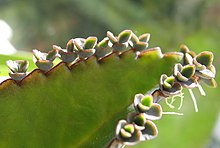Asexual reproduction
Asexual reproduction is reproduction without sex.
In this form of reproduction, a single organism or cell makes a copy of itself. The genes of the original and its copy will be the same, except for rare mutations. They are clones.
The main process of asexual reproduction is mitosis. This type of reproduction is common among some single-cell organisms, for example, Amoeba. Many plants also reproduce asexually, for example by means of runners. The individual zooids in a particular coral or bryozoan are usually genetically identical. They are formed by asexual reproduction of the first individual to arrive in a place. One whole order of the rotifers, the bdelloid rotifers, has no sexual reproduction. Many types of living things have a double cycle. At one stage they have sexual reproduction, at another they simply multiply by splitting, or producing eggs which develop without fertilisation (aphids). All the daughters of the honey bee develop from unfertilised eggs. So, asexual reproduction is common in many forms of life.[1][2]
Types of asexual reproduction[change | change source]
Binary fission[change | change source]

Some organisms like bacteria reproduce using binary fission. They split in two, so one bacterium becomes two bacteria. This always leads to daughter cells, and the offspring will be identical to the parent.
Budding[change | change source]

Budding is similar to binary fission, but it is used by plants and some animals, which cannot simply split in half as bacteria can. It is when a small part of a plant or animal breaks off and then, while they are separated from their "mother", they start to grow until both the "parent" and the "offspring" are the same size and both are capable of budding again. This may happen many more times.
Parthenogenesis[change | change source]
Parthenogenesis is found in both plants and animals. Eggs develop without fertilisation. Examples occur in water fleas, rotifers, aphids, stick insects, some ants, bees and parasitic wasps. Parthenogenesis is very rare for vertebrates.[3]
Vegetative propagation[change | change source]
Very common in some types of plants using rhizomes or stolons (for example in strawberry). Other plants form bulbs or tubers (for example tulip bulbs and dahlia tubers). Some plants may form a clonal colony, where all the individuals are clones, and the clones may cover a large area.
Spores[change | change source]

Fungi (for example, mushrooms) produce spores, which may be asexual or sexual. The asexual spores have the genetic material inside, which allows them to make a whole new organism identical to its parent. They are produced by mitosis. Different fungi make different kinds of asexual spores, conidia, oidia, and pycniospores. The shape and colour of the spores can be helpful to identify the species of fungus.
Sexual vs asexual reproduction[change | change source]
| Type | Advantages | Disadvantages |
|---|---|---|
| Asexual reproduction | No mate needed. Many offspring produced quickly | No variation in the offspring. |
| Sexual reproduction | Genetic variation in the offspring. | Requires both sexes to participate. |
References[change | change source]
- ↑ Dawson K.J. (1995). "The advantage of asexual reproduction: when is it two-fold?". Journal of Theoretical Biology. 176 (3): 341–347. Bibcode:1995JThBi.176..341D. doi:10.1006/jtbi.1995.0203.
- ↑ Engelstädter J. (2008). "Constraints on the evolution of asexual reproduction". BioEssays. 30 (11–12): 1138–1150. doi:10.1002/bies.20833. PMID 18937362. S2CID 5357709.
- ↑ Engl, New; Aquarium. "Two baby Anaconda born in all-female adult exhibit". New England Aquarium. Archived from the original on 2019-06-01. Retrieved 2019-06-01.
